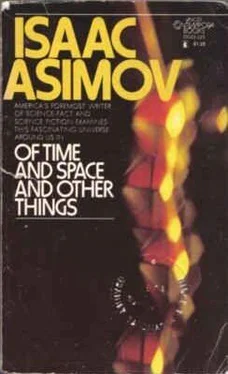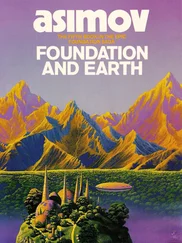Isaac Asimov - Of Time and Space and Other Things
Здесь есть возможность читать онлайн «Isaac Asimov - Of Time and Space and Other Things» весь текст электронной книги совершенно бесплатно (целиком полную версию без сокращений). В некоторых случаях можно слушать аудио, скачать через торрент в формате fb2 и присутствует краткое содержание. Год выпуска: 1972, ISBN: 1972, Издательство: Lancer Books, Жанр: Прочая научная литература, на английском языке. Описание произведения, (предисловие) а так же отзывы посетителей доступны на портале библиотеки ЛибКат.
- Название:Of Time and Space and Other Things
- Автор:
- Издательство:Lancer Books
- Жанр:
- Год:1972
- ISBN:ISBN: 0-447-33023-3
- Рейтинг книги:4 / 5. Голосов: 1
-
Избранное:Добавить в избранное
- Отзывы:
-
Ваша оценка:
- 80
- 1
- 2
- 3
- 4
- 5
Of Time and Space and Other Things: краткое содержание, описание и аннотация
Предлагаем к чтению аннотацию, описание, краткое содержание или предисловие (зависит от того, что написал сам автор книги «Of Time and Space and Other Things»). Если вы не нашли необходимую информацию о книге — напишите в комментариях, мы постараемся отыскать её.
Of Time and Space and Other Things — читать онлайн бесплатно полную книгу (весь текст) целиком
Ниже представлен текст книги, разбитый по страницам. Система сохранения места последней прочитанной страницы, позволяет с удобством читать онлайн бесплатно книгу «Of Time and Space and Other Things», без необходимости каждый раз заново искать на чём Вы остановились. Поставьте закладку, и сможете в любой момент перейти на страницу, на которой закончили чтение.
Интервал:
Закладка:
Of these two months, the solar month is far more useful to mankind because the phases of the Moon depend on the relative positions of Moon and -Sun. It is therefore 29-5306 days, or one solar month, from new Moon to new Moon, or from full Moon to full Moon. In ancient times, when the phases of the Moon were used to mark off the seasons, the solar month became the most iinpor tant unit of time.
Indeed, great pains were taken to detect the exact day on which successive new Moons appeared in order that the calendar be accurately kept (see Chapter 1). It was the place of the priestly caste to take care of this, and the very word "calendar," for instance, comes from the Latin word meaning "to proclaim," because the beginning of each month was proclaimed with much ceremony. An assembly of priestly officials, such as those that, in ancient times, might have proclaimed the beginning of each month, is called a "synod." Consequently, what I have been calling the solar month (the logical name) is, actually, called the synodic month."
The farther a planet is from the Sun and the faster it turns with respect to the stars, the smaller the discrepancy between its sidereal day and solar day. For the planets beyond Earth, the discrepancy can be ignored.
For the two planets closer to the Sun than the Earth the discrepancy is very great. Both Mercury and Venus turn one face eternally to the Sun and have no solar day. They turn with respect to the stars, however, and have a sidereal day which @ out to be as long as the period of their revolution about the Sun (again with respect to the stars).
If the various true satellites of the Solar System (see Chapter 7) keep one face to their primaries at all times, as is very likely true, their sidereal day would be equal to their period of revolution about their primary.
If this is so I can prepare a table (not quite like any I have ever seen) listing the sidereal period of rotation for each of the 32 major bodies of the Solar System: the Sun, the Earth, the eight other planets (even Pluto, which has a rotation figure, albeit an uncertain one), the Moon, and the 21 other true satellites. For the sake of direct corn parison I'll give the period in minutes and list them in the order of length. After each satellite I shall put the name of the primary in parentheses and give a number to represent the position of that satellite, counting outward from the primary.
Sidereal Day
Body (minutes)
Venus 324,000
Mercury 129,000
Iapetus (Satum-8) 104,000
Moon (Earth-1) 39,300
Sun 35,060
Hyperion (Saturn-7) 30,600
Callisto (Jupiter-5) 24,000
Titan (Satum-6) 23,000
Oberon (Uranus-5) 19,400
Titania (Uranus-4) 12,550
Ganymede (Jupiter-4) 10,300
Pluto 8650
Triton (Neptune-1)
Rhea (Saturn-5) 6500
Umbriel (Uranus-3) 5950
Europa (Jupiter-3) 5100
Dione (Satum-4) 3950
Ariel (Uranus-2) 3630
Tethys (Saturn-3) 2720 lo (Jupiter-2) 2550
Miranda (Uranus-1) 2030
Enceladus (Saturn-2) 1975
Deimos (Mars-2) 1815
Mars 1477
Earth 1436
Mimas (Satum-1) 1350
Neptune 948
Amaltheia (Jupiter-1) 720
Uranus 645
Saturn 614
Jupiter 590
Phobos 460
These figures-represent the time it takes for stars to make a complete circuit of the skies from the frame of reference of an observer on the surface of the body in question. If you divide each figure by 720, you get the number of minutes it would take a star (in the region of the body's celestial equator) to travel the width of the Sun or Moon as seen from the Earth.
On Earth itself, this takes about 2 minutes and no more, believe it or not. On Phobos (Mars's inner satellite), it takes only a little over half a minute. The stars will be whirling by at four times their customary rate, while a bloated Mars hangs motionless in the sky. What a sight that would be to see.
On the Moon, on the other hand, it would take 55 minutes for a star to cover the apparent width of the Sun.
Heavenly bodies could be studied over continuous sustained intervals nearly thirty times as long as is possible on the Earth. I have never seen this mentioned as an advantage for a Moon-based telescope, but, combined with the absence of clouds or other atmospheric, interference, it makes a lunar observatory something for which astron omers ought to be willing to undergo rocket trips.
On Venus, it would take 450 minutes or 7'h hours for a star to travel the apparent width of the Sun as we see it. What a fix astronomers could get on the heavens there - if only there were no clouds.
7. Just Mooning Around
Almost every book on astronomy I have ever seen, large or small, contains a little table of the Solar System. For each planet, there's given its diameter, its distance from the sun, its time of rotation, its albedo, its density, the number of its moons, and so on.
Since I am morbidly fascinated by numbers, I jump on such tables with the perennial hope of finding new items of information. Occasionally, I am rewarded with such things as surface temperature or orbital velocity, but I never really get enough.
So every once in a while' when the ingenuity-circuits in my brain are purring along with reasonable smoothness, I deduce new types of data for myself out of the material on band, and while away some idle hours. (At least I did this in the long-gone days when I had idle hours.)
I can still do it, however, provided I put the results into formal essay-form; so come join me and we will just moon around together in this fashion, and see what turns up.
Let's begin this way, for instance…
According to Newton, every object in the universe attracts every other object in the universe with a force (i) that is proportional to the product of the masses (ml and M2) of the two objects divided by the square of the distance (d) between them, center to center. We multiply by the gravitational constant (g) to convert the propor tionality to an equality, and we have-. f = 9MIM2 (Equation 1) d2
This means, for instance, that there is an attraction be tween the Earth and the Sun, and also between the Earth and the Moon, and between the Earth and each of the various planets and, for that matter, between the Earth and any meteorite or piece of cosmic dust in the heavens.
Fortunately, the Sun is so overwhelmingly massive corn 'Pared with everything else in the Solar System that in calculating the orbit of the Earth, or of any other planet, an excellent first approximation is attained if only the planet and the Sun are considered, as though they were alone in the Universe. The effect of other bodies can be calculated later for relatively minor refinements.
In the same way, the orbit of a satellite can be worked out first by supposing that it is alone in the Universe with its primary.
It is at this point that something interests me. If the Sun is so much more massive than any planet, shouldwt it exert a considerable attraction on the satellite even though it is at a much greater distance from that satellite than the primary is? If so, just how considerable is "considerable"?
To put it another way, suppose we picture a tug of war going on for each satellite, with its planet on one side of the gravitational rope and the Sun on the other. In this tug of war, how well is the Sun doing?
I suppose astronomers have calculated such things, but I have never seen the results reported in any astronomy text, or the subject even discussed, so I'll de it for myself.
Here's how we can go about it. Let us call the mass of a satellite m, the mass of its primary (by which, by the way, I mean the planet it circles) m,, and the mass of the Sun m.. The distance from the satellite to its primary will be d, and the distance from the satellite to the Sun will be d.. The gravitational force between the satellite and its primary would be J, and that between the satellite and the Sun would be fg-and that's the whole business. I promise to use no other symbols in this chapter.
Читать дальшеИнтервал:
Закладка:
Похожие книги на «Of Time and Space and Other Things»
Представляем Вашему вниманию похожие книги на «Of Time and Space and Other Things» списком для выбора. Мы отобрали схожую по названию и смыслу литературу в надежде предоставить читателям больше вариантов отыскать новые, интересные, ещё непрочитанные произведения.
Обсуждение, отзывы о книге «Of Time and Space and Other Things» и просто собственные мнения читателей. Оставьте ваши комментарии, напишите, что Вы думаете о произведении, его смысле или главных героях. Укажите что конкретно понравилось, а что нет, и почему Вы так считаете.












